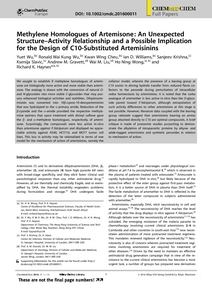Wu, Y; Wu, RW; Cheu, KW; Williams, ID; Krishna, S; Slavic, K; Gravett, AM; Liu, WM; Wong, HN; Haynes, RK
(2016)
Methylene Homologues of Artemisone: An Unexpected Structure-Activity Relationship and a Possible Implication for the Design of C10-Substituted Artemisinins.
ChemMedChem, 11 (13).
pp. 1469-1479.
ISSN 1860-7187
https://doi.org/10.1002/cmdc.201600011
SGUL Authors: Krishna, Sanjeev Liu, Wai Man
![[img]](https://openaccess.sgul.ac.uk/108058/1.hassmallThumbnailVersion/Methylene%20artemisone%20CMC%2016.pdf)  Preview |
|
PDF
Accepted Version
Available under License ["licenses_description_publisher" not defined].
Download (1MB)
| Preview
|
Abstract
We sought to establish if methylene homologues of artemisone are biologically more active and more stable than artemisone. The analogy is drawn with the conversion of natural O- and N-glycosides into more stable C-glycosides that may possess enhanced biological activities and stabilities. Dihydroartemisinin was converted into 10β-cyano-10-deoxyartemisinin that was hydrolyzed to the α-primary amide. Reduction of the β-cyanide and the α-amide provided the respective methylamine epimers that upon treatment with divinyl sulfone gave the β- and α-methylene homologues, respectively, of artemisone. Surprisingly, the compounds were less active in vitro than artemisone against P. falciparum and displayed no appreciable activity against A549, HCT116, and MCF7 tumor cell lines. This loss in activity may be rationalized in terms of one model for the mechanism of action of artemisinins, namely the cofactor model, wherein the presence of a leaving group at C10 assists in driving hydride transfer from reduced flavin cofactors to the peroxide during perturbation of intracellular redox homeostasis by artemisinins. It is noted that the carba analogue of artemether is less active in vitro than the O-glycoside parent toward P. falciparum, although extrapolation of such activity differences to other artemisinins at this stage is not possible. However, literature data coupled with the leaving group rationale suggest that artemisinins bearing an amino group attached directly to C10 are optimal compounds. A brief critique is made of proteomic studies purporting to demonstrate the alkylation of intraparasitic proteins by alkyne- and azide-tagged artemisinins and synthetic peroxides in relation to mechanism of action.
| Item Type: |
Article
|
| Additional Information: |
This is the peer reviewed version of the following article: Y. Wu, R. W. K. Wu, K. W. Cheu, I. D. Williams, S. Krishna, K. Slavic, A. M. Gravett, W. M. Liu, H. N. Wong, R. K. Haynes, ChemMedChem 2016, 11, 1469, which has been published in final form at https://doi.org/10.1002/cmdc.201600011. This article may be used for non-commercial purposes in accordance with Wiley Terms and Conditions for Use of Self-Archived Versions. |
| Keywords: |
C-glycosides, antimalarial activity, antitumor agents, mechanisms, peroxides, Medicinal & Biomolecular Chemistry, 0304 Medicinal And Biomolecular Chemistry, 0305 Organic Chemistry, 1115 Pharmacology And Pharmaceutical Sciences |
| SGUL Research Institute / Research Centre: |
Academic Structure > Infection and Immunity Research Institute (INII) |
| Journal or Publication Title: |
ChemMedChem |
| ISSN: |
1860-7187 |
| Language: |
ENG |
| Dates: |
| Date | Event |
|---|
| 7 June 2016 | Published | | 7 June 2016 | Accepted |
|
| Publisher License: |
Publisher's own licence |
| Projects: |
|
| PubMed ID: |
27273875 |
 |
Go to PubMed abstract |
| URI: |
https://openaccess.sgul.ac.uk/id/eprint/108058 |
| Publisher's version: |
https://doi.org/10.1002/cmdc.201600011 |
Statistics
Item downloaded times since 15 Aug 2016.
Actions (login required)
 |
Edit Item |



